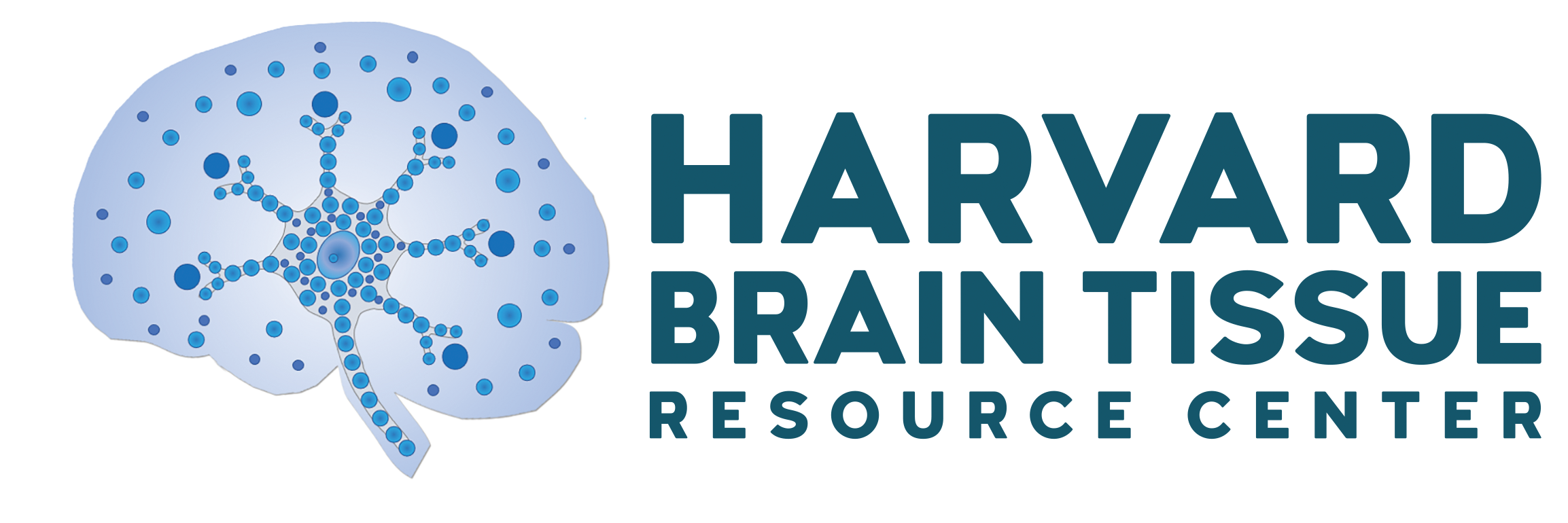Investigators
Quality Controls
Several measures are taken to ensure tissue quality. These include:
- Keeping the postmortem time interval (PMI) as short as possible (on average below 24 hours from death to storage of the tissue)
- Taking all measures to ensure that the donor's body is refrigerated and that the tissue is kept cold at all times until storage
- Implementation of exclusionary criteria including known or suspected infectious diseases (HIV, Hep B, Hep C, prion disease), cause of death (such as stroke or other conditions damaging the brain), prolonged time on respirator, etc.
- LNV as freezing method for all frozen blocks (Vonsattel et al., 2008)
- A dissection protocol designed to reduce repeated tissue freeze/thaw cycles
Quality controls include serology screening for all cases, toxicology screening for selected cases through a centralized NBB site, full neuropathology reports on all cases, and measurements of pH and RIN for all cases.
Tissue pH
Tissue pH is measured from fresh tissue during the brain dissection process. A small piece of the occipital cortex is weighed and placed in water at neutral pH (1.0 ml/100.0 mg of tissue). The tissue is homogenized, and pH values are measured in triplicate using a standard Corning electrode at room temperature.
RNA Integrity Number (RIN) and DNA quality
RINs are measured from frozen tissue dissected from the occipital cortex. A 6mm disposable biopsy punch is used to collect a 30 mg tissue sample. The sample is then run through a bead disrupter and tissue homogenizer. DNA/RNA is extracted from the homogenized tissue using a Qiagen Allprep DNA/RNA Mini Kit. The extracted liquid RNA is then quantified using the Invitrogen Qubit Fluorometer System. The qualification (RIN) of the RNA is measured using the Agilent Technologies RNA Nano Chip System with the Agilent 2100 Bioanalyzer System. DNA quality (e.g. fragmentation) can be measured using the Agilent DNA 1000 High Sensitivity DNA kit.
Neuropathology
Neuropathological assessment is carried out for all brain samples by the HBTRC neuropathologists, Drs. Daniel Mordes and Derek Oakley, who generate a formal neuropathology report. Brain specimens are given a detailed gross and microscopic assessment closely following the neuropathology protocol described by Montine et al. and the immunocytochemistry protocols described by Dickson et al. (Dickson et al., 2010; Dickson et al., 2009; Dugger and Dickson, 2017; Vonsattel et al., 1995; Vonsattel et al., 2008; Montine et al., 2012).
Gross Brain Evaluation
The formalin-fixed hemisphere is weighed, and the external surfaces are examined for lesions, atrophy, swelling and malformations. The major arteries are inspected for atherosclerosis. The brainstem is dissected from the forebrain at the level of the pretectum. The cerebellum is then removed from the brainstem. The cerebral hemisphere is cut coronally into 0.5 cm slices, the brainstem is cut in cross section into 0.25 cm slices, and the cerebellum is cut sagittally at 0.25-0.5 cm. Lesions, atrophy, malformations and other changes from normal seen on the cut surfaces are recorded, including semiquantitative scores for pigment loss in the substantia nigra and locus coeruleus. Sixteen standard tissue blocks are taken for each case, including non-affected (healthy) controls, psychiatric disorders and neurodevelopmental disorders. Additional blocks are taken as dictated by the intake diagnosis and gross findings. Examples include: an additional block of cortex where it appears most atrophied (e.g. corticobasal degeneration and supranuclear palsy); a second block of midbrain with substantia nigra in Parkinson's disease and control cases; a second block of neostriatum in Huntington cases. In addition, blocks are taken of grossly identified lesions such as cerebellar vermal atrophy, mammillary body atrophy, surgical lesions, surgical therapeutic transplants, and apparent infarcts, hemorrhages, malformations, abscesses or tumor metastases.
Neurohistological Preparation and Assessment
The dissected tissue blocks are placed in cassettes, immersed in buffered formalin, dehydrated, cleared, embedded in paraffin and sectioned on a standard rotary microtome at a thickness of 5 um. For all cases, a section from each block is then stained with a combination of Luxol fast blue and hematoxylin and eosin (LFB-H&E).
All donors who are over 65 years old or have a history of dementia will be evaluated using a staining and immunohistochemical panel designed to detect and stage common forms of dementia, including Alzheimer's disease, Lewy body disease and Frontotemporal lobar degeneration. Cases fitting the above criteria will be evaluated using Luxol H&E, Bielchowsky silver stain (Biel) and immunohistochemistry for the presence of beta-amyloid, phosphorylated-tau (AT8), phosphorylated TDP-43 and alpha-synuclein. This routine workup is especially important as many cases can have mixed pathology, e.g. a combination of Alzheimer's disease pathology, Lewy body disease pathology and vascular pathology contributing to cognitive changes. All cases with Alzheimer's disease neuropathological changes are being reported through multiple scoring systems, including the Braak stage for neurofibrillary tangles (NFTs), Thal stage for amyloid deposition, and CERAD score for neuritic plaques. Following current NIA guidelines, these components are then combined to generate an ABC score (Montine et al. 2012) and the likelihood of Alzheimer's disease dementia based on the underlying pathology. Because it has also been recognized that TDP-43 pathology may contribute to cognitive decline in Alzheimer's disease, we also assess for the presence of pathologically phosphorylated TDP-43 (pTDP-43) in all cases using a phospho-specific antibody. For cases of Parkinson's disease (PD), Parkinson's disease with dementia (PDD) and Lewy body dementia (LBD), both the Newcastle criteria and the Braak and Braak stage for alpha-synuclein neuropathology are reported. In addition, the standard set of blocks taken for neuropathologic evaluation has been expanded to include anterior cingulate gyrus for improved evaluation of the distribution of Lewy bodies in these disorders. pTDP-43 and p62 stains will also be performed on all cases of Amyotrophic Lateral Sclerosis.
Example Alzheimer's disease (AD) Neuropathologic diagnosis: Alzheimer Disease Neuropathologic Change (ADNC):
- Thal stage 5 for amyloid deposition
- Braak and Braak tangle stage VI/VI
- CERAD age related plaque score: 3
- NIA-Alzheimer Association score: A3B3C3 High probability of dementia due to Alzheimer's Disease
Combinations of Bielschowsky stain, AT8 and AΒ on sections from selected blocks are used for evaluation of senile plaques, neurofibrillary tangles, Pick bodies, glial tau inclusions, axons, glial cuneiform inclusions in multiple system atrophy, and axonal swellings, amyloid angiopathy and amyloid plaques. Special stains such as PAS, Gram, acid-fast, etc., are also available to evaluate microorganisms and other unusual findings. The most common IHC stains include phosphorylated tau (p-tau, AT8 antibody), TDP-43, alpha-synuclein, AΒ, polyglutamine, glial fibrillary acidic protein (GFAP), myelin basic protein (MBP), CD-68. Antibodies used generally follow the recommendations of Dickson (Dickson et al., 2010; Dugger and Dickson, 2017; Kuhlmann et al., 2017), and are described below under specific diagnoses.
Neuropathological Diagnosis
The HBTRC neuropathologists formulate a final report that contains all pertinent gross and microscopic information as well as neuropathological diagnoses and any additional comments. The neuropathology report is sent to the donor's LNOK/LR and, when requested by the latter, to other family members and the donor's clinicians. The report is formulated to adhere to the highest pathology standards and serves to answer any questions the family may have, effectively convey information to any pathologists or clinicians the family chooses to share the report with, and provide information pertinent to prospective research use of the tissue (Hutchins, 1995). Examples of criteria for neuropathological diagnosis for the principal categories of movement disorders and dementias are summarized below.
Alzheimer's Disease (AD)
An advanced stage of this disorder is strongly suspected in cases with clinical diagnosis of dementia, where the locus coeruleus (LC) on gross examination shows strong depletion of pigment, while the substantia nigra (SN) is normal or has only mild pigment loss. For diagnosis, clinicopathological correlation of disease severity, and to provide researchers with a semiquantitative scale of severity that allows investigation of early, middle and late stages, Braak and Braak staging is carried out in addition to confirmation of the presence of AΒ deposits and amyloid angiopathy. IHC stains for neurofibrillary pathology (neurofibrillary tangles, neuropil threads and neuritic plaques) and for amyloid deposits (senile plaques) using the AT8 antibody for abnormally phosphorylated tau, and an antibody against AΒ on several brain regions (Braak et al., 2006; Braak and Braak, 1991; Braak and Braak, 1995; Braak and Braak, 1997; Grober et al., 1999; Nelson et al., 2012; Nelson et al., 2009).
Parkinson's Disease (PD) and Dementia with Lewy bodies (DLB)
These disorders have the similar pathology. After observing at gross examination pigmented neuron loss in both SN and LC, alpha-synuclein IHC is carried out to determine if the case is classical PD stage 3 of Braak and Del Tredici or limbic or cortical stage of DLB (Braak and Del Tredici, 2008; Braak and Del Tredici, 2017; Del Tredici and Braak, 2008; Del Tredici and Braak, 2013; Dickson et al., 2009). In PD and LBD, Lewy bodies plus neuron loss are typically seen in the SN and LC together. Progression to stages 4 and 5 correlates with increasing cognitive decline and Lewy bodies present in limbic and cortical areas.
Multiple System Atrophy (MSA)
Alpha-synuclein IHC is done to identify the MSA-specific oligodendroglial inclusions (Ahmed et al., 2013; Koga and Dickson, 2018).
FrontoTemporal Lobar Degeneration (FTLD), Progressive Supranuclear Palsy (PSP), Corticobasal Degeneration (CBD), Pick Disease (PiD) FTLD-TDP contains TDP-43 positive neurites and cytoplasmic inclusions. FTLD-FUS is FUS-positive. FUS IHC done after negative result with TDP-43. FTLD-tau cases (previously called FTDP-17) require p-tau (AT8) IHC. Additional staining for 3R and 4R can be useful. Pick disease is 3R-tau positive. Corticobasal degeneration (CBD) is 4R-tau positive. PSP, which has a different pattern of neuronal loss pathology from most FTLD cases, but is included under the broad FTLD umbrella, is also 4R-tau positive (Dickson et al., 2010; Dugger and Dickson, 2017; Mackenzie et al., 2007; Mackenzie et al., 2010).
Amyotrophic lateral sclerosis (ALS) and ALS-FTLD including ALS-FTLD-TDP and ALS-FTLD-C9orf72 For IHC characterization, we use p62 and TDP-43 (Gellersen et al., 2017). IHC for p62 is used to rule in/out C9orf72 cases (Highley et al., 2016; Ince et al., 2003; Ince et al., 1998).
Huntington's disease (HD)
The Vonsattel grading of neostriatal pathology (Vonsattel et al., 1985) is used for diagnostic scoring. Advanced cases with standard clinical history and family history demonstrate characteristic findings on LFB-H&E. Diagnosis can be confirmed using polyglutamine and p62 IHC, which show intranuclear inclusions routinely (Hedreen et al., 1991; Mattsson et al., 1974; Vonsattel et al., 1985).
Multiple Sclerosis (MS)
Diagnosis of MS and classification of active, mixed active/inactive, and inactive lesions with or without ongoing demyelination is based on the presence or absence of myelin degradation products within the cytoplasm of macrophages/microglia (Kuhlmann et al., 2017). For this classification of MS lesions, we use myelin IHC for antibodies against myelin basic-protein (MBP), as well as detection of macrophages/microglia by, e.g., anti-CD68 (Kuhlmann et al., 2017; Parmar et al.).

